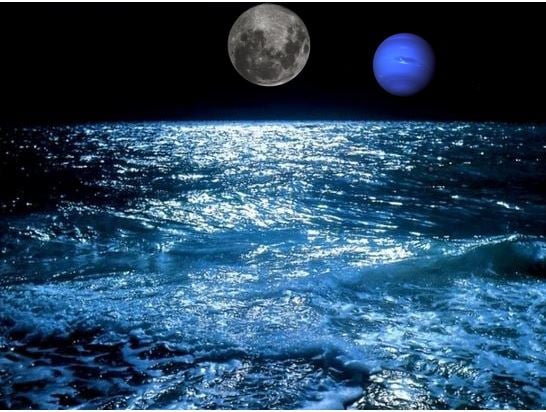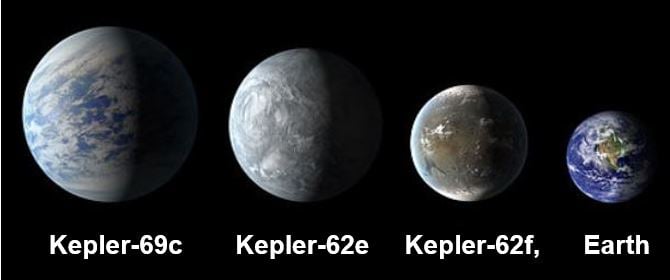A distant planet that might have life, or could have the ideal conditions for life to emerge, has scientists in the United States excited. The exoplanet – known as Kepler-62f – which is about 1,200 light years from Earth, appears to be a ‘good prospect for a habitable world’, the astronomers said.
An exoplanet is one that is outside our solar system.
Scientists from the University of California in Los Angeles (UCLA) and the University of Washington in Seattle wrote about their research and findings in the journal Astrobiology.
 Kepler-62f, the furthest planet from parent star Kepler-62, might be a habitable planet, say scientists. It is in the habitable zone (the green area in the bottom image). (Top Image: nasa.gov. Bottom Image: nasa.gov)
Kepler-62f, the furthest planet from parent star Kepler-62, might be a habitable planet, say scientists. It is in the habitable zone (the green area in the bottom image). (Top Image: nasa.gov. Bottom Image: nasa.gov)
They explained that for a planet to be ‘habitable’, conditions would have to be right for liquid water to exist on its surface, i.e. its temperature would need to be neither too cold nor too hot.
In this study, the authors combined climate and orbit models on the exoplanet, which is about forty percent larger than our Earth in size, and found that there is a very good chance that it has the ideal environment to sustain life as we know it – the kind of life that emerged on Earth.
Kepler-62f is 1,200 light years from Earth, in the direction of the constellation Lyra. Lead author Aomawa Shields, a National Science Foundation astronomy and astrophysics postdoctoral fellow at UCLA’s Department of Physics and Astronomy, explained that it is within the range of exoplanets out there that are probably rocky with a good chance of having oceans.
Scientists set up several scenarios
NASA’s Kepler space observatory, which has been searching the Universe for Earth-like planets which might have life, discovered Kepler-62f and the Kepler-62 solar system three years ago.
 For life as we know it to exist in another planet, it would need an atmosphere and liquid water.
For life as we know it to exist in another planet, it would need an atmosphere and liquid water.
The parent star – Kepler-62 – which is cooler and smaller than the Sun, has five exoplanets orbiting it. Kepler-62f is the furthest away from the star. No data on this exoplanet’s orbit, composition or atmosphere had been produced, that is, until this now.
Dr. Shields and colleagues from the University of Washington – Rory Barnes, Victoria Meadows, Cecilia Bitz, Benjamin Charnay, and Eric Agol – set out to determine whether this exoplanet had the necessary conditions to sustain life as we know it.
They set up a series of possible scenarios to determine what its orbital path and atmosphere might be like.
Regarding Kepler-62f’s chances of having liquid water on its surface, Dr. Shield said:
“We found there are multiple atmospheric compositions that allow it to be warm enough to have surface liquid water. This makes it a strong candidate for a habitable planet.”
Kepler-62f is much further from its parent star than we are from the Sun, which means it would have to have considerably more CO2 (carbon dioxide) than we have in our atmosphere. Only 0.04% of Earth’s atmosphere consists of carbon dioxide.
CO2 and the greenhouse effect
We all hear environmentalists talking about the greenhouse effect as if it were something evil – it is not. The greenhouse effect is a natural process in which specific gases in a planet’s atmosphere absorb the energy (heat) from the parent star’s light, resulting in a higher atmospheric temperature.
 The Kepler-62 planets are all larger than Earth – Kepler-62f is 40% bigger. (Image: Wikipedia)
The Kepler-62 planets are all larger than Earth – Kepler-62f is 40% bigger. (Image: Wikipedia)
These gases are called greenhouse gases, and CO2 is one of them. On Earth, the other most common greenhouse gases, apart from carbon dioxide, are ozone, methane and nitrous oxide.
Had greenhouse gases not existed on Earth there would not have been a greenhouse effect – there would be no life on our planet. The problem now is that we are producing too much CO2 and other greenhouse gases, which are pushing up the temperature of Earth’s surface.
The researchers ran computer simulations on this exoplanet having:
– Several atmosphere types: ranging from one Earth atmosphere to twelve times thicker than what we have.
– CO2 concentrations: ranging from 0.04% of the atmosphere to 2,500 the concentration found on Earth.
After assuming many different CO2 concentrations, they found several scenarios in which this exoplanet could be habitable.
Kepler-62f would need lots of CO2
For Kepler-62f to be habitable all year round, the authors said its atmosphere would have to be from three to five times thicker than ours, and made up of virtually pure CO2.
Because it is far from its parent star, the high CO2 atmospheric concentration would be necessary to make it warm enough for liquid water to be present.
Dr. Shields explained:
“But if it doesn’t have a mechanism to generate lots of carbon dioxide in its atmosphere to keep temperatures warm, and all it had was an Earth-like amount of carbon dioxide, certain orbital configurations could allow Kepler-62f’s surface temperatures to temporarily get above freezing during a portion of its year. And this might help melt ice sheets formed at other times in the planet’s orbit.”
The researchers used HNBody, an existing computer model, to make their calculations for Kepler-62f’s orbital path. To simulate its climate, they used two existing models – the Laboratoire de Me´te´orologie Dynamique Generic model and the Community Climate System Model.
The authors said that they were the first scientists to combine the results from these two kinds of models when studying a distant planet.
In fact, what they did could be used to determine whether much closer exoplanets might be habitable, as long as we were fairly sure that they were rocky, the authors claimed.
Dr. Shields said:
“This will help us understand how likely certain planets are to be habitable over a wide range of factors, for which we don’t yet have data from telescopes.”
“And it will allow us to generate a prioritized list of targets to follow up on more closely with the next generation of telescopes that can look for the atmospheric fingerprints of life on another world.”
There is life out there – Dr. Shields believes
No evidence has been found so far regarding life existing outside our planet. However, Dr. Shields believes we will get lucky one day.
Our galaxy, the Milky Way, has billions and billions of stars and planets. So, far, scientists have confirmed the existence of 2,300 exoplanets. There are several thousand others waiting to be confirmed. However, only a couple of dozen are known to be within the Habitable Zone.
The Habitable Zone, also called the Goldilocks Zone, is a distance from a parent star in which a planet’s temperature could be just right for liquid water – and therefore life – to exist. Earth is in our Solar System’s Habitable Zone.
Just a couple of dozen contenders does not sound like many. But remember, that is out of just the 2,300 exoplanets that we have discovered so far. Twenty-four in every 2,300 is just over 1%. There are billions of exoplanets in the Milky Way – 1% of several billions is a big number; and that is just in our galaxy. Scientists say there are at least one hundred billion galaxies in our Universe.
Citation: Barnes Rory, Bitz Cecilia, Agol Eric, Charnay Benjamin, Shields Aomawa L., and Meadows Victoria S. “The Effect of Orbital Configuration on the Possible Climates and Habitability of Kepler-62f,” Astrobiology. May 2016. DOI: 10.1089/ast.2015.1353.
Video – What could Kepler-62f look like?
This video animation shows what Kepler-62f might look like, that is, if you allow your imagination to wander. Who knows?
